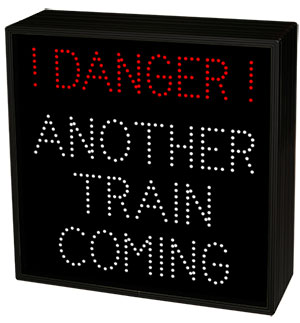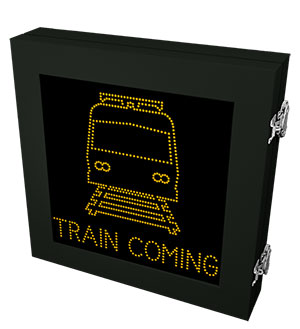
Railroad crossings — where railway lines intersect roads and sidewalks — are possibly the most dangerous places motorists and pedestrians can find themselves. Trains don’t stop at these crossings, and they have the right of way 100 percent of the time over all vehicles and pedestrians. Because of this, they rely on motorists and pedestrians to keep clear of the tracks in advance to avoid accidents. That’s why the Manual on Uniform Traffic Control Devices (MUTCD) requires the use of a railroad crossing “crossbuck” sign whenever railroad tracks intersect a public roadway or pathway. However, additional measures can be taken to improve motorist and pedestrian safety, such as traffic and rail authorities implementing passive and active railroad crossing warning signs.
Passive Warning Signs and Mechanisms
Passive railroad crossing warning signs are any static sign, device, or mechanism that warns motorists and pedestrians about an upcoming railroad crossing. These include, but aren’t limited to:
- Barriers
- Fences
- Pavement markings
- Fixed message signs
- Raised roads making a hill at train tracks
- Swing gates
These are the typical, everyday warning signs seen when driving through small towns and other low-traffic areas. They provide static messages of warning, guidance, and in some instances, mandatory action for the driver or pedestrian. They also identify and direct attention to the location of a crossing to permit drivers and pedestrians to take appropriate action. While passive railroad crossing warning signs can effectively limit railroad safety incidents and accidents, their active sign counterparts turn the alert and safety levels up a notch.
Active Warning Signs, Devices, and Mechanisms

Investing in active warning signs for railroad crossing is a superior choice for crossings with heavy rail, motor vehicle, and pedestrian traffic. These signs are an excellent way to provide enhanced warnings, bolster safety, and, hopefully, reduce the number of railroad crossing safety incidents. Active warning signs, mechanisms, and devices include, but aren’t limited to:
- Flashers
- Audible active warning devices
- Automated pedestrian gates
Active warning signs benefit railroad crossings with heavy pedestrian traffic, crossings with multiple tracks, and intersections where a turn leads motorists to a railroad crossing. All of these environments have escalated levels of danger that should be mitigated through signage, such as:
Adding to this dangerous environment is the modern engineering that makes today’s trains faster and quieter than ever, not producing the classic, revealing “clackety-clack” sound of older trains. This means that approaching trains take longer to hear, are always closer than they seem, and move faster than they appear. And when there are pedestrians who are hearing impaired or are using headphones, the danger is magnified. For these reasons, a combination of audible and visual devices is the best approach to alerting every pedestrian and every motorist of the potential danger of an oncoming locomotive. The active, audible warning can be any sound — a loud buzzer, a series of chirps, an automated voice announcing the oncoming train — that alerts passersby of an upcoming train.
Railroad crossings requiring safety improvements should be studied and reviewed by appropriate engineering teams to select the proper passive and active warning devices. Several types of crossings can benefit from these studies, including:
- High-volume pedestrian traffic crossings
- Tracks with frequent trains
- Tracks with high-speed trains
- Wide railroad crossings
- Complex crossings
- Crossings within school zones
- Crossings with poor sight distance
- Crossings with multiple tracks

Once implemented, train crossing warning systems should be accompanied by increased and ongoing education via Public Service Announcements, added information in a state’s Driver’s Education Manual, and other educational initiatives. Further, safety regulations that prohibit dangerous actions by pedestrians and motorists should be actively enforced.
Signal-Tech is the leading LED sign company for active railroad crossing warning signs and total solutions. If you’re ready to improve motorist and pedestrian safety at railroad crossings, we’re ready to provide you with the signage and solutions to do it. Contact us today to learn more about our MUTCD compliant, active railroad crossing warning signs!


